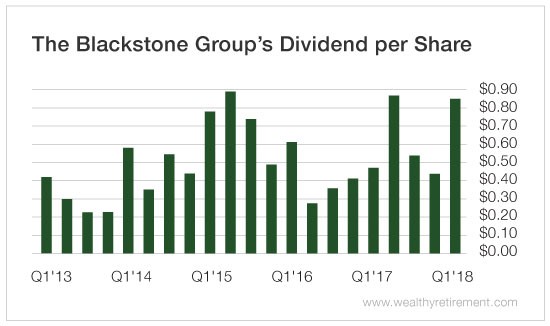Correction: In yesterday’s article about retirement, we stated that it took the market eight to 10 years to recover after the Great Recession, when the S&P 500 actually took only about 5 1/2 years to make a full recovery (less than five years when you include dividends). While it was a rough several years for investors – especially for those who hoped to retire during that time – the market has more than made up for it. In fact, the S&P 500 is currently up nearly 75% since before the Great Recession. This proves one thing… Over the long term, the market moves in one direction: up.
That said, there are bound to be corrections along the way. That’s why I always say, “You should not invest any money in stocks that you need in the next three years and can’t afford to lose. Stocks go up over the long term, so if your time horizon is several years out and you can tolerate a correction or bear market, invest in stocks. If you can’t, keep whatever money you need out of the market.”
The Blackstone Group (NYSE: BX) is a financial institution that runs hedge funds, mutual funds and private equity funds.
Over the past 12 months, the company has paid out $2.70 per share in dividends, which translates to a 7.8% yield on today’s prices.
If you look at the stock on some online platforms, you may see a yield of 9.9%. That’s because the most recent payment was $0.85. Annualized, that comes out to nearly 10%.
With most stocks, you can annualize the latest payment to get a good estimate of what your dividend will be for the full year. Not so with Blackstone.
The company’s policy is to pay 85% of distributable earnings, with some adjustments as necessary. In other words, it’s a variable dividend policy. So the amount shareholders receive each quarter swings wildly, as the chart below shows…
The good news is that because the company has a strict dividend policy, it can always afford whatever dividend it is paying. It’s not going to get in trouble making dividend promises it can’t deliver on.
In 2018, Wall Street expects Blackstone to pay out $1.53 billion, which would come out to $2.42 per share. That’s a bit higher than the $2.32 it paid in 2017 but lower than the $3.40 that the last quarter’s dividend would be if it were annualized.
Blackstone shareholders should expect to enjoy a fairly high yield going forward, but they must be prepared for extreme variations in the dividend, including some quarters where the dividend is cut in half and others where it doubles.
Distributable earnings will vary depending on when Blackstone exits certain positions. For example, if this quarter it sells a stock or a private equity investment for a $50 million gain, that $50 million becomes part of distributable earnings. The following quarter, if it does not have a $50 million gain that it cashes out, distributable earnings would be lower and so would the dividend.
The dividend safety rating is right in the middle because the company can afford the dividend as it stands today. But in reality, shareholders should expect a dividend cut as earnings fluctuate.
Dividend Safety Rating: C
If you have a stock whose dividend you’d like me to analyze, leave the ticker in the comments section below.
Good investing,
Marc


